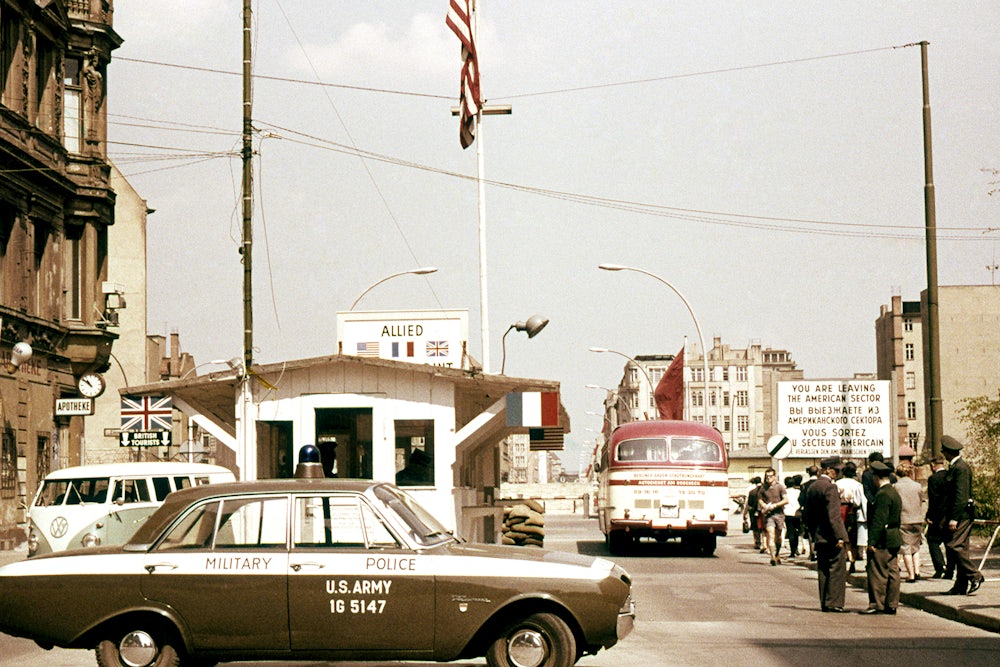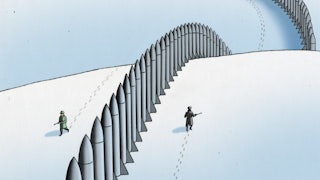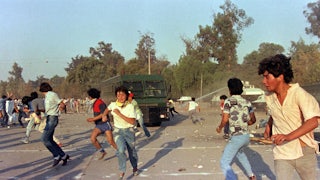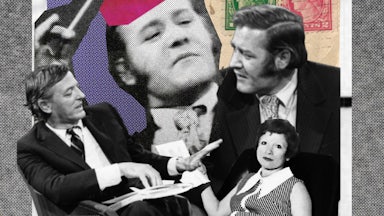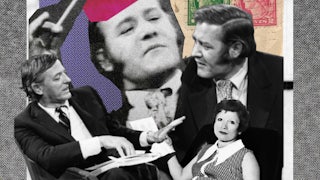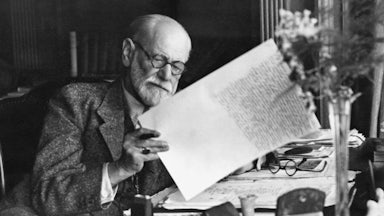In 2005, the historian John Lewis Gaddis proposed in these pages that the United States adapt its Cold War strategy to the “war on terror,” as it was then termed. Even though he recognized that stateless terrorists posed a very different kind of threat than the Soviet Union’s multinational empire did, he nonetheless strove to salvage a series of lessons. He was far from alone in drawing such analogies: In the decades since the Berlin Wall fell, foreign policy elites have looked back on the Cold War with longing. From realists, such as John Mearsheimer and Robert Kaplan, to hawks like Niall Ferguson and Robert Kagan, thinkers have too often succumbed to the lure of nostalgia, whether to forecast post–Cold War anarchy or to valorize U.S. interventions.

In his new book, The Twilight Struggle, the historian Hal Brands is the latest to fall back on Cold War thinking. He believes that, just as the Soviet Union once posed an existential threat to the United States, China and Russia today threaten American power and prosperity and “the fate of freedom around the world.” China, he suggests, wants to displace the U.S. as the most powerful actor in Asia and the Pacific, after which it will pursue domination in Eurasia and international institutions and undermine democracies everywhere. Russia, while less powerful in the long term, wants to control areas formerly held by the Soviet Union, to undermine NATO and the European Union, and to destabilize world order generally. In this new contest, he proposes, the U.S. should repurpose Cold War strategy to emerge victorious.
There is more at stake in Brands’s book than nostalgia. The Twilight Struggle arrives at a time when it would be particularly dangerous to take an overly aggressive approach to relations with China and Russia. Vladimir Putin’s invasion of Ukraine has caused 1.7 million refugees to flee the country, and the death toll is possibly in the thousands. The Russian leader, who has the world’s largest stockpile of nuclear weapons at his disposal, even put his nuclear forces on high alert. South Carolina’s Senator Lindsey Graham tweeted that someone should assassinate Putin, and Mississippi’s Senator Roger Wicker recommended establishing a no-fly zone over Ukraine, although Russia has said that such a move would make NATO a participant in the conflict. Meanwhile, the COMPETES Act has just passed the House of Representatives, allocating $500 million for media outlets such as the U.S. Agency for Global Media to pump out negative coverage of China. Congress is evidently readying for a new Cold War with China that, like the last Cold War, might not remain cold.
While The Twilight Struggle sets out to offer guidance derived from the past, what it inadvertently shows is how unnecessarily destructive much of U.S. Cold War policy was and how it persists in clouding understanding of our moment. It’s worth studying this mode of thinking, precisely so that we can avoid it in the current crisis and find a better path.
The Twilight Struggle begins with the Truman years. In the closing stages of World War II, President Roosevelt had hoped that cooperation between the United States and the USSR would extend beyond the war, but he did not live to see the end of the conflict. After his death in April 1945, it fell to Truman, his vice president, to navigate the postwar order. The ground was soon shifting. In all of Eastern Europe, the Mediterranean, and even in Iran, Stalin demanded unconditional deference in areas he considered vital to Soviet interests, and he distrusted American intentions in the United Nations and other multilateral venues.
Brands deems the Truman administration’s response “heroic.” The unassuming Truman—a former haberdasher from the Midwest who didn’t graduate college and who, as president, once threatened to punch a newspaper columnist in the face for writing that his daughter played piano poorly—worked with such well-bred members of the Eastern establishment as Dean Acheson, James Byrnes, George Marshall, and George Kennan to establish American policy. Kennan, a brilliant but erratic diplomat, sought to explain Soviet behavior, which mystified American officials who had considered the empire a friendly wartime ally: In his view, Kremlin leaders possessed the same insecurity and fear of Western penetration that centuries of Russian czars had suffered, alongside an anti-capitalist worldview. Peaceful coexistence with the Soviets wasn’t possible until a new mentality took hold.
Kennan observed, however, that unlike Hitler, Stalin wasn’t eager to go to war. Instead, the Soviet leader wanted to rebuild a shattered empire and could wait for the Western powers to make war on each other, as they surely would. The U.S. could avoid the extremes of either waging a preventative military campaign against the Soviet Union or withdrawing from European affairs entirely. Soviet expansion, he wrote, could instead “be contained by the adroit and vigilant application of counterforce at a series of constantly shifting geographical and political points.” The strategy, elaborated over a series of essays and telegrams, became known as “containment.” Kennan’s writings were long on history, analysis, and general strategy but noticeably short on concrete policy prescriptions. Brand observes that “containment’s most frustrating qualities were also its greatest virtues.” The strategy’s vagueness allowed policymakers to fill in the blanks with appropriate adaptations.
Truman’s team worked to amplify the Soviet threat in the minds of the American public. There was already a core of anti-Communist sentiment among Americans; Truman played up the paranoia by declaring that “every nation must choose between alternative ways of life” and framing the Cold War as requiring that “it must be the policy of the United States to support free peoples who are resisting attempted subjugation by armed minorities or by outside pressures.” This framing—along with the careful shepherding of the Republican Party’s isolationist wing—was essential to building support in Congress for a range of Cold War initiatives. Over nearly eight years, the Truman administration oversaw previously unthinkable increases in defense spending. It constructed multilateral international organizations, such as NATO, and national security institutions, including the CIA. It saw the passage of the Marshall Plan (as much the brainchild of Kennan and Undersecretary of State Dean Acheson as of Secretary of State George Marshall), which brilliantly helped restore the economic and political confidence of Western Europeans.
Its National Security Council efficiently directed the organs conducting foreign affairs. Truman provided aid to anti-Communist forces in Europe and Asia and pledged to provide similar help around the world, including by backing French colonial forces against Communists in Vietnam, bringing about the entry of the U.S. into another war. Kennan swore that he had intended containment to be applied primarily in Europe and Japan, but that’s the price of vagueness.
The Truman administration’s escalation in rhetoric and action set the tone for U.S. practice throughout the Cold War. Once policymakers had a larger defense budget and national security apparatus as their disposal—especially once the Korean War began—it was easy for them to use it. American policymakers extended financial and military support to brutal anti-Communist elements from Nicaragua to Laos to South Africa. In Pakistan, for instance, President Nixon supported Pakistan as it killed hundreds of thousands of Bengalis in 1971. A few years later, Gerald Ford supplied Indonesia with weapons and diplomatic cover to invade East Timor, launching an occupation that lasted 25 years and caused the deaths of more than 100,000 people. The list goes on.
Brands suggests that overwhelming nuclear weapons capabilities and a massive military were necessary to build the “free world.” The Truman administration was satisfied that the Soviet Union did not have the capacity to mount a successful invasion of Western Europe, yet worried, Brands writes, that “a military imbalance could still undermine the political will of U.S. allies.” Similarly, Brands suggests that a climate of fear and paranoia was a prerequisite to keeping the public engaged in the Cold War struggle. “The Truman administration’s fusing of geopolitics and ideology was necessary to create a Cold War consensus,” Brands writes. He acknowledges that McCarthyism was “far more destructive than the threat it was meant to counter.” But he concludes that domestic spying and harassment fell short of the oppression in the Soviet system. He even says that, “viewed positively, the outcome showed that American democracy proved stronger than McCarthy’s demagoguery.”
Brands has, in fact, an unusually rosy view of America’s Cold War adventures. Like the leaders he venerates—Brands has hardly a bad word to say about anybody who served in government from 1944 to 1992, with the exception of Joseph McCarthy—he is little concerned with the bloodiness of the country’s actions in Korea, Indonesia, Chile, or elsewhere. Although he writes of the abundant failures of the Vietnam War for the U.S., he neglects the immense destruction the U.S. inflicted on the Vietnamese, as many as three million of whom were killed. He also muses that “U.S. resistance in Vietnam probably limited Communist gains in Southeast Asia by preserving the lead domino until the others were no longer so wobbly”—ultimately a win. And while he mentions that the U.S. suffered “mistakes and setbacks” in the Cold War, he concludes that “America eventually accomplished nearly everything it wanted to.” In this account, wise leadership, a determined and resilient citizenry, and a superior economic and political model defeated the Soviet Union, and offers a blueprint for the future.
In Brands’s view, American leaders are only belatedly noticing ascendant authoritarianism, and the public is unprepared for what will be another decades-long competition with states armed with large militaries and hostile ideologies. “The U.S.-led international system is threatened,” he writes, “by authoritarian powers seeking to redraw the world’s geopolitical map and make the twenty-first century an age of autocratic ascendancy.” He notes China’s threats against Taiwan, its dismantling of Hong Kong’s freedom, and its Belt and Road Initiative, which he sees as an ambitious project to turn Eurasia into a China-led landmass. He observes Russia’s attacks on “former Soviet republics that were leaning toward the West” and points out that Russia is establishing itself as “a player in the Middle East and Africa through arms sales, proxy wars, and even direct intervention.”
Brands harnesses his version of the Cold War to meet these challenges. The U.S. defeated the Soviet Union because presidents and members of Congress did the same thing that militaries do in traditional conflicts: They studied the enemy, created positions of strength, and exploited the opponent’s weaknesses. Since the Soviets could not, for instance, match the U.S. economic and industrial capacity, the U.S. was able to ensure friendly relations with countries in Western Europe by assisting with postwar reconstruction. The U.S. gave $2.4 billion to Japan between 1945 and 1953, crucial largesse for a state that had been reduced to rubble. The U.S. also allowed its allies unfettered access to its enormous market while overlooking their protectionism.
But Brands also endorses some of America’s bloody actions, which bodes ill for his suggestion that they offer a template for current foreign policy. “The strategic effects of the Reagan Doctrine were particularly pronounced,” he writes about such actions as arming anti-Communist forces in Central America, which he admits “bled the people as well as the government of Nicaragua, where the death toll during the 1980s was higher, in proportional terms, than American fatalities in the Civil War, the world wars, and the Korean and Vietnam wars combined”—efforts that succeeded in “severely straining the regime.” Similarly, he endorses what he calls “low-price successes,” observing that when the CIA helped overthrow Iran’s democratically elected prime minister in 1953, it ensured a friendly government there for another 25 years.
For Brands, covert action and flexibility are needed again to combat Russia and China lest America allow the enemies of freedom to run amok around the world. He cautions against backing these countries into corners, but he adds, “There is no path to success that doesn’t involve making China and Russia pay exorbitantly for aggressive policies.” He recommends that the U.S. work with friendly autocrats in Asia and the Middle East, accepting that “Washington will surely find itself relying on expedients, from covert action to outright coercion, it would never sanction at home.” It should orient its foreign policy around defeating China and Russia, strengthening allies like Japan and Taiwan, mobilizing Americans to defend freedom around the world, denying technologies to our adversaries, and planning our society to battle these countries for decades to come.
Brands may also overstate the extent of China’s and Russia’s ambitions. There is no doubt that both countries have implemented repression at home and both have menaced their neighbors. And as Russia’s horrific attack on Ukraine shows, a regional bully can still wreak deadly havoc in unconscionable wars of conquest. But Brands does see not Russia or China as regional powers—large states seeking to maintain a sphere of influence, a security buffer between themselves and challengers. Once established as the leading powers in their neighborhoods, he believes the next stop is global domination. “Regional primacy,” he writes, “is less a destination than a springboard.”
That judgment seems premature, not least because Russia’s
and China’s capabilities lag far behind the West’s. Until that changes, assuming
they are major threats to the U.S. is exaggerated, especially if we
respond to Putin’s nuclear provocations with level-headedness. And by elevating
traditional interstate rivalries to the level of cosmic wars, Brands puts
compromises off-limits. If the U.S. is not just a normal country but the leader
of the Free World, battling not just opponents but exponents of global tyranny,
then compromise becomes verboten, a form of surrender to the forces of
darkness.
Not only does Brands portray relations with China and Russia today as doomed; he significantly downplays the ways the Cold War transformed American society for the worse. When discussing the student-led upheaval and protests inspired by the Vietnam War, for example, he notes that the National Guards shot 13 unarmed students at Kent State University. He doesn’t mention that four of those students died from their gunshot wounds. The subsequent line in the book is this: “Yet the turmoil was nonetheless a reminder that the American system permitted a political spontaneity that Soviet citizens could only dream of.” Whatever Soviet citizens dreamed of, having their own military shoot students was likely not included.
Brands writes as if brutality at home and abroad was necessary to defeat the Soviet Union. But the U.S. could still have won the Cold War without treating the entire globe as a battleground. Melvyn Leffler, Fredrik Logevall, Odd Arne Westad, and other historians have made the case that the U.S. committed crimes that were both unwise and unnecessary. The U.S. always had more and wealthier allies than the Soviet Union did, a far stronger and more diverse economy, and a robust nuclear capability. “From the American point of view, containment had largely been achieved by 1949,” Logevall and his co-author, Campbell Craig, write in their 2009 book, America’s Cold War.
The Twilight Struggle ends with the demise of the Soviet Union. Brands repeats the myth that “the international system was transformed without a shot being fired,” even though in Romania and Afghanistan, leaders violently repressed anti-Communist protests. Although Presidents Ronald Reagan and George H.W. Bush showed flexibility and vision in dealing with Mikhail Gorbachev by signing arms agreements, reducing confrontational rhetoric, and praising the Soviet general secretary, U.S. leaders also caused needless pain by insisting on maximal objectives: M.E. Sarotte’s recent book Not One Inch shows that Secretary of State James Baker (and West German leaders) told Gorbachev that if the Soviet Union left East Germany, NATO would not expand eastward. When the Soviets left, the Americans unwisely reneged on their promise, enlarging the military alliance deep into Russia’s neighborhood. This broken promise caused some of the anger that led Russia to embrace the anti-American positions Brands now sees as proof of its unceasing hostility.
Fifteen years since Gaddis recommended a Cold War–style war on terror, it should be clear that Gaddis’s thinking relied on one flawed, unexamined assumption: that the war needed to be waged in the first place. Al Qaeda was a relatively minor threat magnified into an existential menace, including by intellectuals conversant in fatuous historical analogies. For numerous reasons, they wrongly insisted that the challenges posed by stateless, resource-strapped terrorist groups called for the most powerful country in the world to draw up grand strategies involving interventions in the Middle East and beyond.
Brands repeats the mistake by applying America’s Cold War strategy to China and Russia. Although Brands suggests that their undemocratic regimes make them automatically hostile to the U.S., the very autocracies he now says are irreversibly united against us were each other’s enemies for decades but friendly with us, the most powerful democracy. Autocrats in Southeast Asia and the Middle East are friendly toward the U.S. Why are autocratic regimes in Beijing and Moscow inevitably hostile? Russia’s invasion of Ukraine has rendered any immediate possibility of friendly relations between Russia and the U.S. impossible. But in stabler times, the actions we take can affect the level of animosity we face. That should lead American policymakers to seek opportunities for cooperation with our adversaries and restrain from threatening them.
In all his historical excavations, Brands underplays the value of converting enemies into friends, as the U.S. did with China in the 1970s, our greatest diplomatic achievement during the Cold War. There are times when crises emerge and we have to take action, as we are doing with our robust package of sanctions directed at Russia. But generally, history suggests that cooperation is possible between countries even when they are powerful and ideologically opposed. The U.S. allied with both the Soviet Union and Communist China at times, and for most of the nineteenth century, democratic (albeit imperial) Great Britain was allied with autocratic Russia.
Amid all the lessons The Twilight Struggle takes from the Cold War, the book overlooks perhaps the most important one. It, too, was furnished by Kennan, who wrote much else besides the containment essays. He observed once that “the first thing we Americans need to learn to contain is, in some ways, ourselves.” As The Twilight Struggle shows, the need remains.
